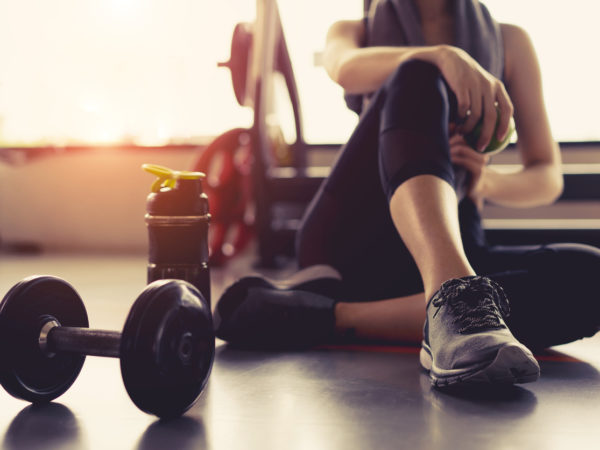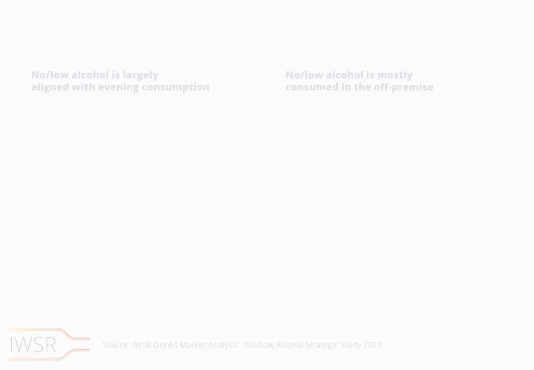
No/low alcohol brands tend to largely target locations and occasions where traditional alcohol brands would be purchased and consumed. However, IWSR research shows that there is a much broader opportunity for no/low brands to compete in new spaces unavailable to traditional strength alcohol.
When analysing the no/low category across 10 key markets (Australia, Brazil, Canada, France, Germany, South Africa, Japan, Spain, the UK and the US), IWSR consumer research data highlights two key overarching trends:
1- No/low has largely aligned with evening consumption across the 10 key countries, with 73% of respondents reporting that they most frequently drink no/low-alcohol beverages in the evening. Some markets are a bit more nuanced – Spain, for example, has an established culture of daytime drinking, and there was a relatively even split between daytime and evening consumption of no/low beverages. Daytime consumption was also shown to be strong in South Africa.
2- The most popular occasion to consume no/low products is when relaxing at home, and the category’s suitability to low-tempo occasions is a key reason why it has been so resilient during the pandemic. Further to this, IWSR data shows that no/low heavily over-indexes on the off-trade, with 75.4% of respondents stating they usually consider purchasing no/low beverages in grocery stores.

These consumer research trends, along with IWSR market data, show an opportunity for no/low alcohol brands to:
1- Cultivate a greater presence in the traditional on-trade (such as bars, pubs, clubs, restaurants, and cafés), and we are already seeing venues expand their on-trade offering beyond a single no- or low-alcohol option. For example, at Brewdog’s UK-based pub, Brewdog AF, claimed to be the world’s first alcohol-free pub, there are multiple stouts, IPAs and fruit flavoured beers on offer.
2- Play in non-traditional venues such as spas, gyms, health food shops and florists/gift shops. Here, brands would compete in a different product pool that includes offerings such as soft drinks, juices, smoothies, premium teas, CBD infusions and kombuchas.
The no/low alcohol category’s strong alignment with health and wellness, as well as its premium positioning, means it has the ability to go head-to-head with other wellness-focused products and not merely be positioned as an alternative to alcohol. This is especially true for the no-alcohol category, for which venues would not have to apply for an alcohol licence.
Some brands are already exploring the less traditional spaces and occasions for no/low alcohol, and are expanding their distribution accordingly. “We’ve started looking at spas, studios and hairdressers, as there’s such a link between the category and health and wellness,” says Paul Mathew, founder of alcohol-free aperitif brand Everleaf. “We’re also looking at sporting events, drive-in cinema experiences and events like that where alcohol isn’t as appropriate, but organisers still want to have a premium offering,” he adds.
As the no/low alcohol category broadens its channel mix, brand owners will likely need to establish new distribution networks that cater to locations such as spas or health food shops rather than traditional alcohol venues. This is where the intersection of the no/low alcohol category and the wider drinks industry, such as soft drinks, creates an interesting source of innovation. As soft drinks companies face increasing scrutiny from sugar activists, for example, the health and wellness movement offers an interesting avenue for cross-over. In early August 2020, Coca Cola became one of the latest brands to tap into the momentum of the hard seltzer category, which, like the no/low category, resonates with consumers interested in health & wellness cues.
Functionality-focused innovation could also become a key element for brands looking to get into non-traditional spaces. A similar trend has taken hold in Japan, where there has been a surge in the number of RTD brands tapping into health cues. In other markets, this could prove to be a particularly strong selling point in gyms, spas, sporting events and venues that offer brunch. In the US, an increasing number of brewers are tapping into functionality cues traditionally held by sports drinks. For example, Harpoon Brewery, Sufferfest Beer Company and Zelus Beer Company, are adding ingredients such as vitamins or electrolytes to their products.
While adhering to local advertising laws would need to be taken into consideration, functionality-focused innovation widens the playing field for the no/low alcohol category as well.
One risk in expanding to new locations and occasions is that brands might spread themselves too thin. For example, brands that target both the gym crowd and club goers may dilute their messaging. As such, future segmentation of the category could play an important role, as different types of no/low propositions could effectively target different locations and occasions.
You may also be interested in reading:
What’s driving growth in the no/low alcohol space?
The Middle East – an untapped market for beverage alcohol innovators?
What does Dry January look like during a pandemic?
Category
Market
- Beer
- Brandy
- Cider
- Gin
- Irish Whiskey
- Low-/No-Alcohol
- Mixed Drinks
- RTDs
- Rum
- Scotch
- Spirits
- Tequila
- US Whiskey
- Vodka
- Whisky
- Wine


